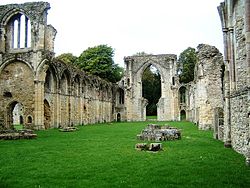 Ruins of the church at Netley Abbey | |
| Monastery information | |
|---|---|
| Full name | The Abbey Church of St Mary of Edwardstow (Sanctae Mariae de Loco Sancti Edwardi) |
| Other names | Latin: Laetus Locus (Happy Place), Lieu-Saint-Edward, Letley |
| Order | Cistercians |
| Established | 1239 |
| Disestablished | 1536/7 |
| Mother house | Beaulieu Abbey |
| Dedicated to | Virgin Mary and Edward the Confessor |
| Diocese | Diocese of Winchester |
| People | |
| Founder(s) | Peter des Roches and Henry III |
| Important associated figures | William Paulet, Abbot Thomas Stevens |
| Site | |
| Location | Netley, Hampshire, United Kingdom |
| Grid reference | SU453090 |
| Visible remains | major ruins of church, monastic buildings and post-Dissolution mansion |
| Public access | open to the public (English Heritage) |
Netley Abbey is a ruined late medieval monastery in the village of Netley near Southampton in Hampshire, England. The abbey was founded in 1239 as a house for monks of the austere Cistercian order. Despite royal patronage, Netley was never rich, produced no influential scholars nor churchmen, and its nearly 300-year history was quiet. The monks were best known to their neighbours for the generous hospitality they offered to travellers on land and sea.
In 1536, Netley Abbey was seized by Henry VIII of England during the Dissolution of the Monasteries and the buildings granted to William Paulet, a wealthy Tudor politician, who converted them into a mansion. The abbey was used as a country house until the beginning of the eighteenth century, after which it was abandoned and partially demolished for building materials. Subsequently the ruins became a tourist attraction, and provided inspiration to poets and artists of the Romantic movement. In the early twentieth century the site was given to the nation, and it is now a Scheduled Ancient Monument, cared for by English Heritage. The extensive remains consist of the church, cloister buildings, abbot's house, and fragments of the post-Dissolution mansion. Netley Abbey is one of the best preserved medieval Cistercian monasteries in southern England.